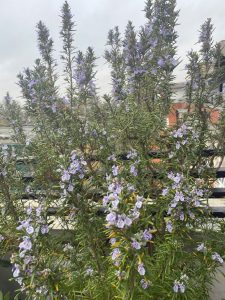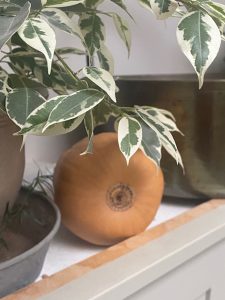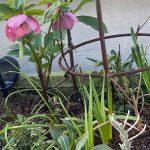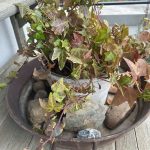The Stuff of Dreams
Not so long ago a visitor to the balcony was unimpressed with the state of health of one of my olives. In other locations around my modest, intricate and compact planting spaces olive trees with different histories have come into my life as gifts or spur of the moment purchases, and flourished, or at least done surprisingly well in their restricted and exposed positions. But outside the bedroom windows is a treasured heirloom with a provenance that I have long forgotten. It has occupied a particularly heavy, and I think splendid terracotta pot, in a prime position, for the last eight or nine years having been transplanted from a much smaller container, and it has never thrived. Not quite an eyesore but certainly not a thing of beauty, prompting my visiting friend to say, without flinching, that he would get rid of it. So the question is, why haven’t I? And more particularly why do I give it more attention than almost any other plant? I do realise that there may be a link between my endeavours and the olive’s lack of enthusiasm, and I do feel somewhat guilty as I think I neglected to give it a good start when I transferred it from its original container – laziness, haste or poor quality planting medium may all have played a part. But for some reason it seems particularly hard to remove this struggling plant, which I suspect in reality will not be too difficult to do as I am pretty sure it has a poorly developed root system.
I have wondered why I can’t let go of this poor example of a robust and life-enhancing species, without really being quite sure of the answer. I am usually more decisive and often ruthless as each plant in a small planted space needs to pay its way; its very existence depending on bringing seasonal charm (ideally with nectar and pollen), making a contribution to the wind-break so we are not beaten back indoors when high winds throw up dust and compost, edible so all herbs are welcome (and I even have the prospect of pomegranates when my miniature shrub is robust enough to carry fruit) or has an interesting story to tell (horticultural or personal).
 However, thanks to my friend’s straightforward acknowledgement that it’s time to get rid of the struggling olive, I have had some embryonic thoughts about what might replace it. It’s tempting to get another olive but they are becoming somewhat ubiquitous hereabouts, outside restaurants and on balconies being favoured spots, so the next question is ‘will this be an opportunity for some seasonal interest or an evergreen shrub?’ The first thing that came to mind was the silver leaved, white flowered, cold tolerant (to -9 C) Convolvulus cneorum. I have one already which enjoys our local conditions, so I might double up. Reading on, and with apologies to the readers who would rather skip over the Latin references, I learn that the Latin specific epithet cneorum is a word of Greek origin referring to a small olive-like plant – who knew?
However, thanks to my friend’s straightforward acknowledgement that it’s time to get rid of the struggling olive, I have had some embryonic thoughts about what might replace it. It’s tempting to get another olive but they are becoming somewhat ubiquitous hereabouts, outside restaurants and on balconies being favoured spots, so the next question is ‘will this be an opportunity for some seasonal interest or an evergreen shrub?’ The first thing that came to mind was the silver leaved, white flowered, cold tolerant (to -9 C) Convolvulus cneorum. I have one already which enjoys our local conditions, so I might double up. Reading on, and with apologies to the readers who would rather skip over the Latin references, I learn that the Latin specific epithet cneorum is a word of Greek origin referring to a small olive-like plant – who knew?
I’m also considering re-planting the struggling olive with due care and attention in another planter in a different location – out of the way so it will hopefully just get on and do it’s own thing. As the location I have in mind is on a very narrow pebble covered connecting pathway, this will involve lowering a new planter out of a side window, followed by bags of compost, broken crocks etc, clambering out of the window (the sill being about 90cms or 3ft above floor level so no good with stiff joints) asking for help with the plant itself, and a watering can, and then making the return journey. As with Holy Matrimony no-one should enter into this endeavour lightly* so I will wait for a fine day and hope for a win-win outcome. Sadly however, as with marriage, the hoped for outcome, a happy union of plant and position, may not be as secure and creative as any early promise suggests.
All in all, and after a number of failed experiments, the roof garden has grown into a welcome sanctuary – especially suited for lingering on balmy days, whatever the season.
*Book of Common Prayer – marriage service
Branching Out
Once Christmas is over and the business of taking down decorations finished for another year I start collecting egg boxes. I don’t often eat eggs but luckily I live with someone whose idea of a happy start to the day is an egg, poached or scrambled, but how to decide I often wonder. To an observer the thought process is very unclear. Meanwhile, I try to stick to the same breakfast menu to avoid an early morning dilemma. Nevertheless, and anxious to help, last year I was very systematic and we accumulated an impressive stack of boxes. Unfortunately they were never used as intended and instead I added them to the compost bins, carefully breaking them up into a rottable size.
We were very late buying seed potatoes for the allotment, the intended occupants of the vacated egg boxes, with chitting being the aim. So unchitted the potatoes were planted and did well. I think we bought late earlies and main crop. They were planted separately, but unlabled, and arrived and were stored together so we didn’t know which was which but it didn’t seem to matter. The only real problem being lack of rain (and watering) so they were all on the smallish side but nevertheless lasted well into December. So for reasons I’m struggling to fully understand this year we have already bought seed potatoes (first earlies and main crop I’m told) which are required to be chitted. The new planting arrangement also involves one planting strip for each variety, no mixed strips, and no fun guessing which variety is which. A pastime I may be overrating somewhat but I’m sorry there will be fewer egg boxes for the compost.
 Meanwhile the charms of our butternut squash are beginning to wane. Some still adorn the tops of the kitchen cupboards decoratively peering down, between trailing house plants, others have been chopped and boxed and still occupy the deep freeze, but less is more I’m beginning to think. However, if like me you still have butternut squash on the menu, and you are searching for a particularly easy pasta and butternut recipe, you might try Roasted squash and red onion pasta – incredibly easy and surprisingly delicious although you can’t avoid the tiresome business of removing the skin, not essential but preferable I think, particularly when you are cooking rather elderly veggies. I also added crispy sage leaves which looked pretty and tasted good too.
Meanwhile the charms of our butternut squash are beginning to wane. Some still adorn the tops of the kitchen cupboards decoratively peering down, between trailing house plants, others have been chopped and boxed and still occupy the deep freeze, but less is more I’m beginning to think. However, if like me you still have butternut squash on the menu, and you are searching for a particularly easy pasta and butternut recipe, you might try Roasted squash and red onion pasta – incredibly easy and surprisingly delicious although you can’t avoid the tiresome business of removing the skin, not essential but preferable I think, particularly when you are cooking rather elderly veggies. I also added crispy sage leaves which looked pretty and tasted good too.
All of which brings me on to the unavoidable topic of aging.
Trips Around the Sun
Having completed another trip around the sun not so long ago (so much easier to contemplate that getting another year older) I have been dwelling on the subject of aging and the inevitable challenges of continuing to garden whatever the space. As I have mentioned before, once upon a time I thought about joining a Local Council run project whereby volunteers are paired with residents who need help with their gardens. In this scenario I saw myself as the one providing gardening knowledge and assistance. Now a few years on I’m closer to being the person in need of assistance, but not yet. Fortunately I can still lift, push, tug, snip etc when necessary and have enough ingenuity and stubbornness to cope with most of the gardening challenges that my high rise space throws up.
But I am making some choices consistent with an imagined simpler planting scheme and fewer containers. All of which involves sourcing larger planters (weight always a consideration) and jettisoning the small pots which will be conveniently available as crocks when crocks are needed. As with the egg boxes, they can be broken up before being recycled for ballast and drainage. For my bigger plants/small trees I favour lightweight steel ‘Dolly tub’ planters apparently finished to have a ‘traditional look based on the tubs used in Victorian wash-houses‘. They suit the balcony and even when full of compost and planted up with olives or other plants can be manoeuvred around with a combination of rolling and pulling. They come in different shapes and sizes so its best to do some measuring before ordering.
I am strongly in favour of supporting our local garden centre, which has recently changed hands after an anxious time when we thought it might be replaced by housing, the fate of many other city garden centres, but I have only found this type of large, light weight container on line.
I ordered two such tall containers, one for the main balcony, one for outside the study/bedroom hoping that when planted up it will screen out some of the Summer sun as this room gets the full force of the morning sunshine. The containers arrived by coincidence at the same time as three bare root Aquilegia vulgaris var. stellata ‘Black Barlow’ which I ordered several months ago and had rather forgotten about. They needed planting straightaway alongside plenty of other early season work – what could possibly go wrong?
The containers were transported in strong card board boxes which can hopefully be re-cycled to good effect and I salve my conscience, given the road miles involved, with the knowledge that the balcony is a miniature haven for wild life. But more immediately problematic was and is the question of size.
The container needed to be passed through a window. The computer and associated paraphernalia had to be moved aside first, together with a narrow desk. An old towel became a temporary floor covering and a reasonably sturdy wooden chair acted as a foot stool. I then, as mentioned above, passed everything I might need through the window, using other planters as temporary shelf space, after which I intended to clamber out ready to receive the planter. Only then did I register that I hadn’t measured the aperture with the sash window open. These pots dent easily, so having belatedly measured both the gap and the girth of the recently arrived container I could see it would be a very tight squeeze. My loyal undergardener up aloft (but not on the allotment when roles are reversed) is someone who would have measured before ordering, and might have drawn attention to my failure to do so, but I was luckier than I deserved and we managed to pass it through the gap without mishap, keeping the container exactly horizontal as we did so.
It only just made it but in doing so without a hitch somewhat undermined my resolve to measure in future. Not something to be proud of but old habits, or failings, die hard.
Green Shoots
 The days are drawing out and plants and shrubs in this part of South West London are perking up. The rosemary bushes are in flower although any cold spells prevent any potentially grateful bumble bee from venturing out. The first flowers emerged tentatively last November which is no longer a surprise as the flowering patterns of many plants have changed. As it is in the wider horticultural world so on our roof garden, with the potential risk of supply and demand being out of sync.
The days are drawing out and plants and shrubs in this part of South West London are perking up. The rosemary bushes are in flower although any cold spells prevent any potentially grateful bumble bee from venturing out. The first flowers emerged tentatively last November which is no longer a surprise as the flowering patterns of many plants have changed. As it is in the wider horticultural world so on our roof garden, with the potential risk of supply and demand being out of sync.
My hellebores are now on the wane but in pots and planters all around green shoots are appearing, to be followed by the flowering stems of narcissi and tulips in due course. Clematis shoots are visible and I hope some snakeshead fritillaries will have survived their rather unnatural living conditions, as they have done in other years.
And the prospect of many happy hours gardening again is a very consoling thought. My long suffering partner through life and its challenges continues to tolerate the numerous bags of compost and grit that make their way through our bedroom to the outdoor space beyond, and until the surrounding greenery comes into full leaf we can enjoy 270 degree views; by craning your neck as you lean out of the east facing windows Canary Wharf comes into view while to the West, in optimum light conditions, the edge of the Chilterns are visible.
But at the moment it is the rolling fields of Cornwall that provide the view – in sunshine and through mist, well away from city sounds. From time to time, and particularly at this time of year when the countryside is waking up, and lambs are venturing into the fields, the countryside is where I hope to be for a few days, before returning like a homing pigeon to my customary roost.
Then and now
Ocle Pychard, Herefordshire
St Issey, Cornwall










This is one of your most beautiful and touching posts. Thankyou for it. I read it after a gruelling session with a patient and it provided me with soothing and a strong sense of feeling less alone in the trials and tribulations of life, relationship, struggle and laughter.
Thank you very much for your comments – I’m pleased that you had time to enjoy reading the recent post in the course of your working day.
I was interested that your potatoes had to be chitted. I think that
when they are thrown out by a seeding machine in the fields surely no
chitting will survive. I must check this on my next trip to Suffolk
where spud growing is taken seriously under acres of plastic sheets.
Then more seriously about AGE, I find the problem is how to stand up
again if I have managed to kneel down. But I do have an invaluable
stool with side handles which always works and I do recommend it even
for allotments.
Thank you for your comments Peter. I’m always surprised by the differences between farming and gardening – parsnips seem to be a very successful food crop (and delicious) but the seeds are very uncertain to germinate on many allotment sites.
And as to AGE – thank you for sharing your experience which I will remember. On the balcony there is fortunately usually a pot to hand to lean on or assist in other ways. They can be very useful perches in between bursts of activity.
I am a bit late to this post but it was a lovely read as ever. Have you ever tried the purple potatoes? Certainly easy to distinguish, though more difficult to spot in the soil when lifting. Full of antioxidants I’m told. Gord likes to surprise visitors with lilac mash as unlike other purple veg they keep their colour when cooked.